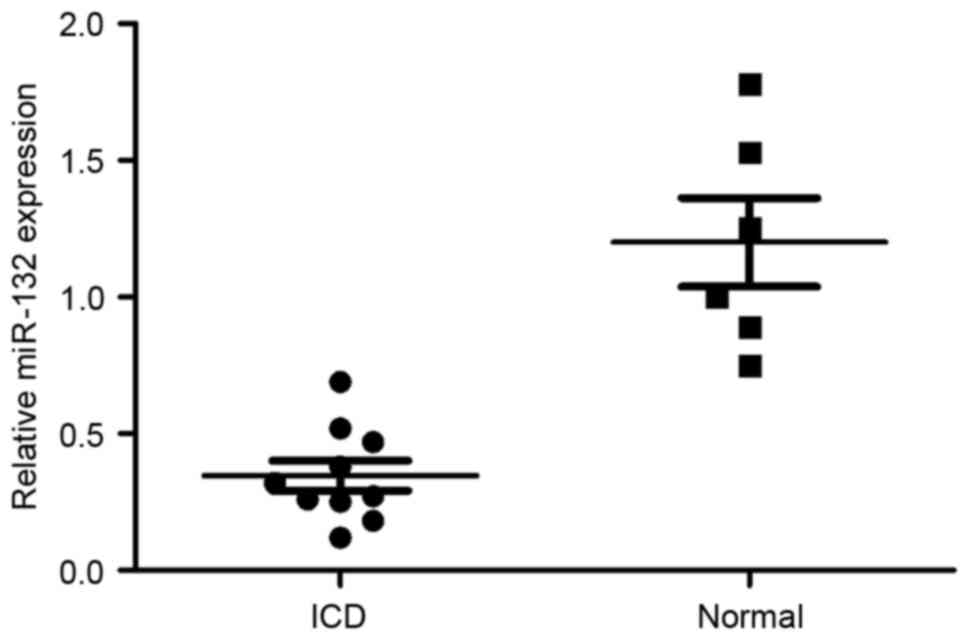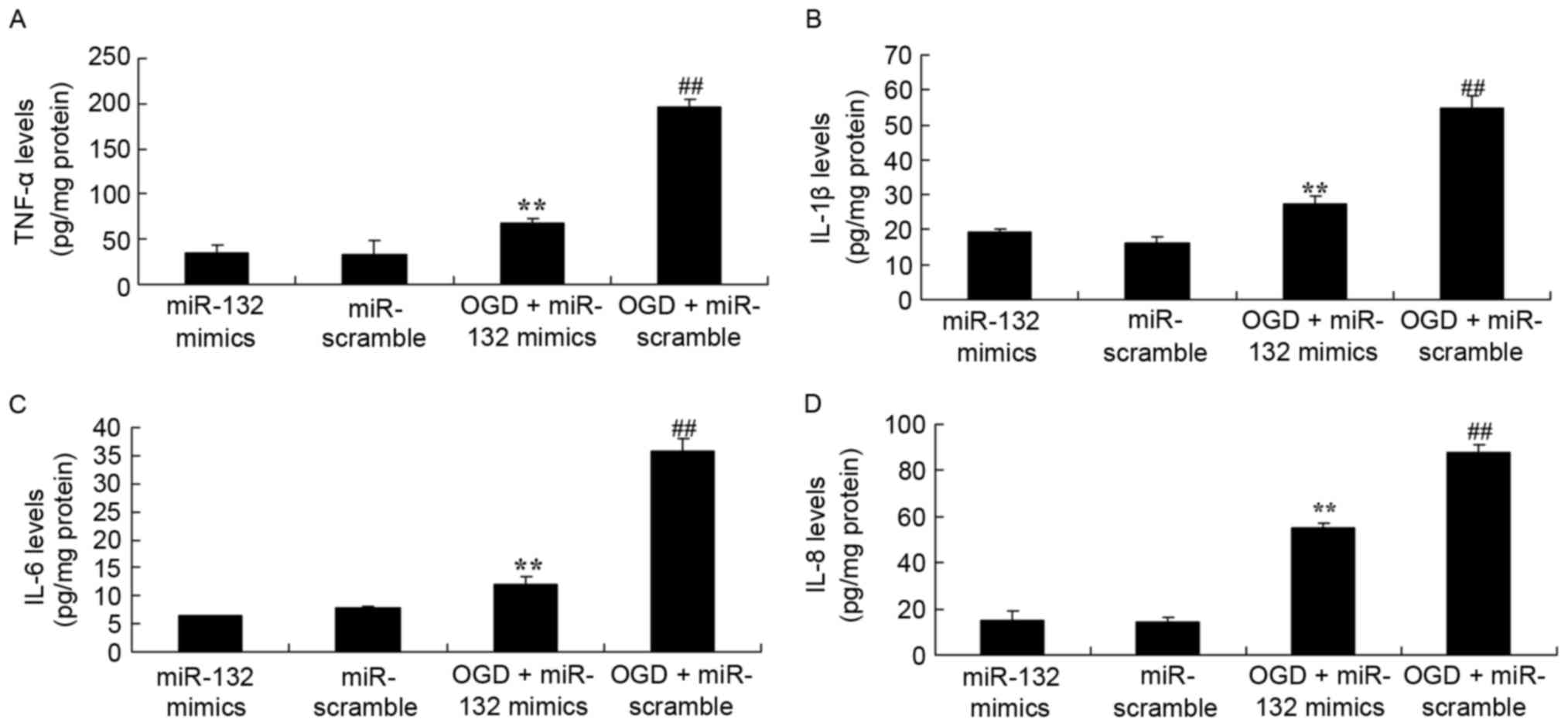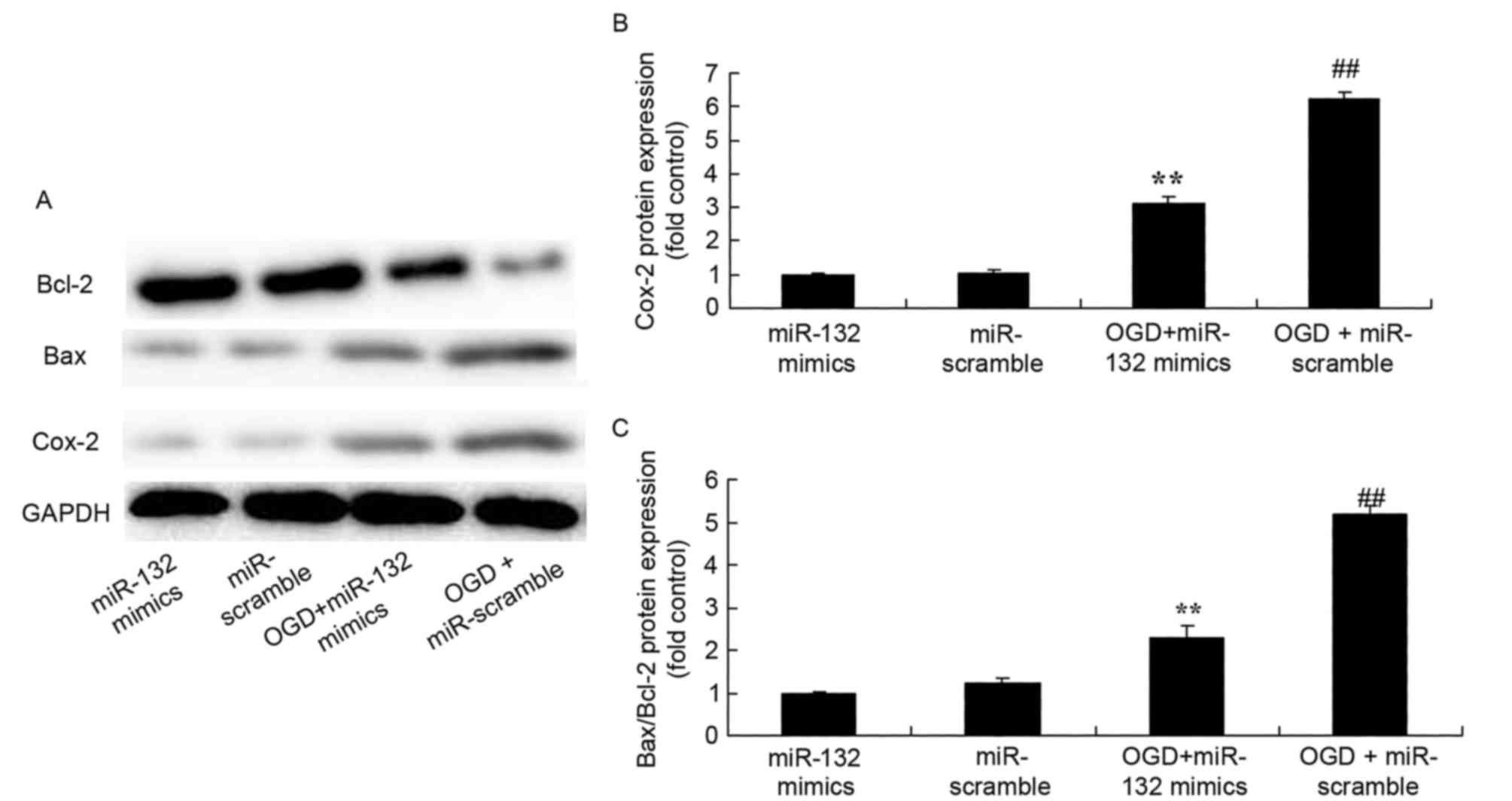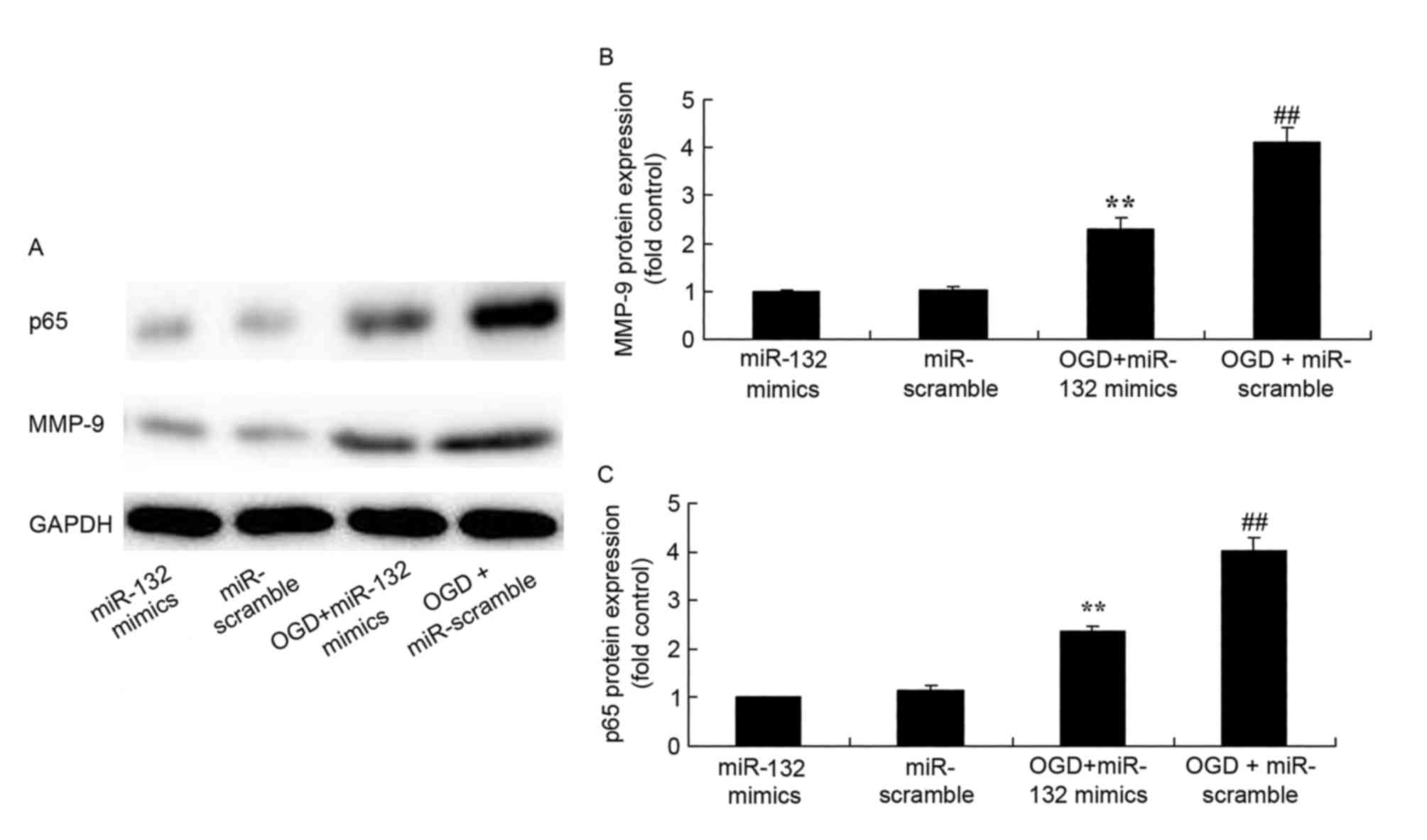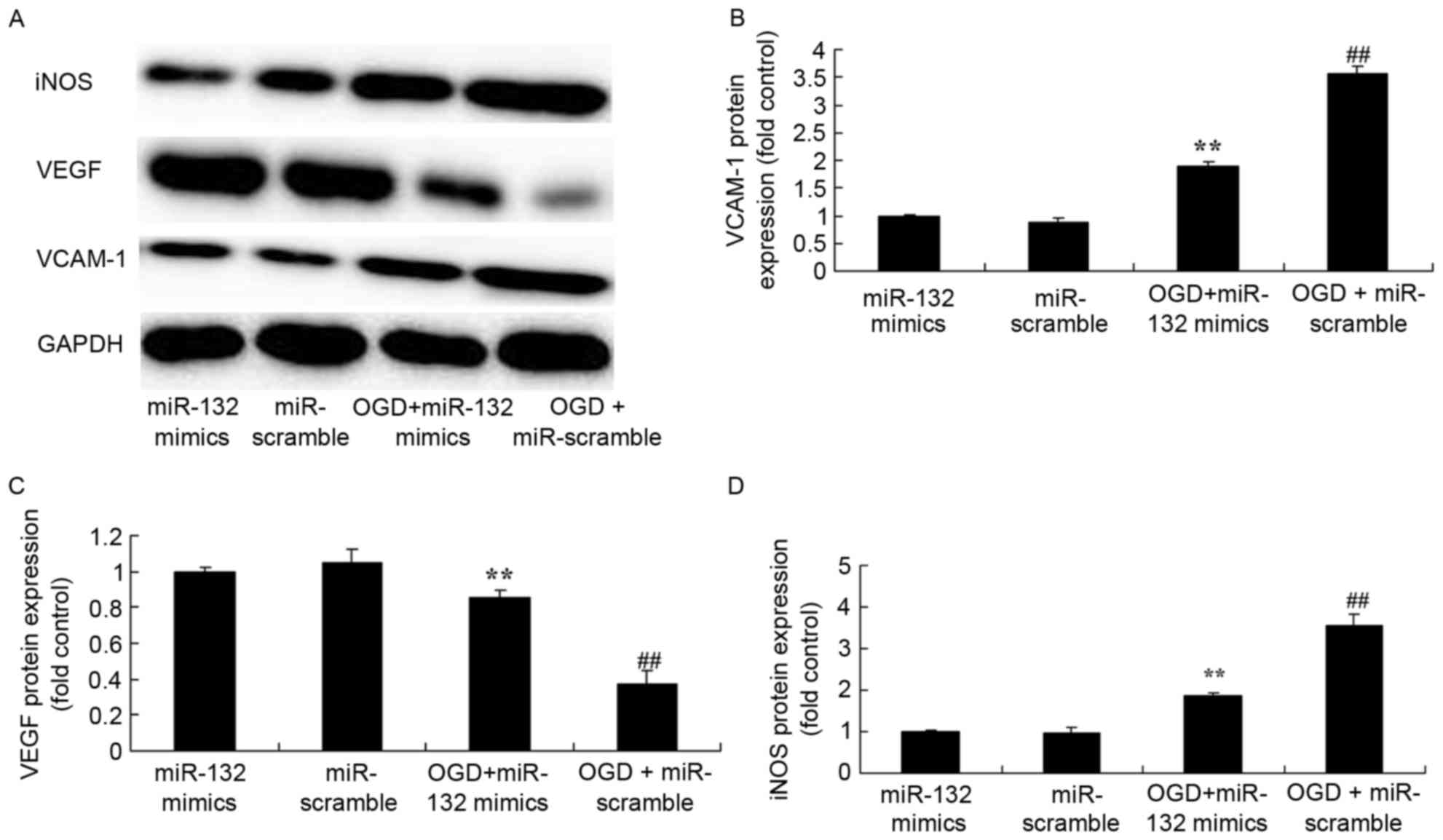MicroRNA-132 modifies angiogenesis in patients with ischemic cerebrovascular disease by suppressing the NF‑κB and VEGF pathway
- Authors:
- Published online on: November 22, 2017 https://doi.org/10.3892/mmr.2017.8138
- Pages: 2724-2730
Abstract
Introduction
Ischemic cerebrovascular disease (ICD) refers to a group of clinical syndromes arising from cerebral circulatory dysfunction of various causes, and brain damage and neurological dysfunction of patients caused by cerebral ischemia, hypoxia and necrosis at the associated blood vessel zone (1). The incidence rate of ICD among cerebrovascular diseases is ~70% in China (2). It has a serious effect on the health and life of patients, is a burden to the family and society, and inflicts substantial social and economic costs (3). According to the data of one survey, it possesses the highest disability and mortality rate in China (4). The incidence rate is rising at an annual growth rate of 8.7%, reflecting China's aging population (1).
ICD originates from a blockage in the local cerebral blood supply following a vascular occlusion, leading to necrosis due to brain tissue ischemia and hypoxia, and the formation of an ischemic penumbra around the necrotic zone (5). A previous study demonstrated that if the blood supply of the ischemic penumbra is recovered in a timely manner at the early stage of cerebral ischemia, the moribund cerebral ischemia tissue may be saved and the damage to the nerve cells of the ischemic region reversed (6). In recent years, in-depth studies on ICD have been performed. By observing numerous clinical records, it may be noted that different levels of increases in microvascular density are observed in the cerebral ischemia tissue of patients with cerebral ischemic injury (7). A study on angiogenesis have demonstrated that the scope and degree of capillary proliferation at the ischemic region are directly associated with reperfusion of the ischemic region, and affect the recovery of neural functions and improve the prognosis of patients (7). These studies are important for the investigation of angiogenic factors, and for the treatment and recovery of patients with ICD (8).
Vascular endothelial growth factor (VEGF) is the specific mitogen that acts directly on vascular endothelial cells. It is the most powerful angiogenic growth factor (9) and promotes angiogenesis via the VEGF receptor (VEGFR). A study demonstrated that the combination of VEGF and VEGFR promotes reclamation of blood vessels at ischemic penumbra, is conducive to the establishment of collateral circulation and serves an important function in the recovery of cellular function following cerebral ischemia (10). At present, a study investigating the involvement of the VEGF/VEGFR system in the promotion of ICD micro-angiogenesis has been performed (11).
The mechanism of ICD involves inflammatory reactions, changes in gene expression, activation of free radicals, protease activation, mitochondrial dysfunction and disorder in the Ca2+ balance (12). With the development of molecular biology, inflammatory reactions have received increased attention. Studies have reported that inflammatory reactions and cell apoptosis are important causes in the aggravation of cerebral ischemia-reperfusion injury. Inflammatory reactions inhibit neuron reclamation and functional rehabilitation following cerebral apoplexy (12,13). At the early stage of cerebral ischemia-reperfusion, the blood-brain barrier is damaged, leading to an increase in vascular endothelium permeability, and the exudation of albumin and other macromolecular proteins into the blood, which subsequently cause local edema (14).
Nuclear factor (NF)-κB promotes adherence, the transmembrane migration of neutrophil granulocytes, leukocyte infiltration, the release of cytokines and chemokines, and leads to the activation of a wide range of brain cells and leukocyte infiltration, which cause further damage to the blood-brain barrier. It also promotes encephaledema aggravation, the apoptosis of neurons, glial and vascular endothelium cells, and serves an important role in reperfusion injury (15,16). ICD may lead to an inflammation cascade reaction and further aggravate cerebral tissue damage (17).
Human source microRNA (miR)-132 is located in chromosome 17pl3.3 and is rich in brain tissues, with a particularly high expression in the hippocampus (18). miR-132 expression is downregulated in a number of diseases associated with the nervous system or in animal models, including Alzheimer's disease, anencephaly, Huntington's disease, schizophrenia and bipolar affective disorder, and Parkinson's disease (19,20). In addition, miR-132 affects the expression of synapse-associated proteins, including NF-κB and VEGF (21,22). The present study investigated the role of miR-132 in modifying angiogenesis in patients with ICD and the underlying mechanism.
Materials and methods
Ethical statement
Study protocols were approved by the Institution Review Board of Beijing Luhe Hospital, Capital Medical University (Beijing, China). Written informed consent was obtained from all participants. Patients with ICD (n=6; 3 male and 3 female; 47.7±12.78 years of age) and healthy volunteers (n=6; 3 male and 3 female; 45.23±8.12 years of age) were recruited from the Department of Neurology, Beijing Luhe Hospital, Capital Medical University between March 2016 and April 2016. Between 8:00 and 9:00 a.m., cerebrospinal fluid (CSF) of all patients and volunteers was collected at L3/L4 or L4/L5 interspace by lumbar puncture.
RNA isolation and reverse transcription-quantitative polymerase chain reaction (RT-qPCR)
Total RNA from CSF samples (0.5 ml) was extracted using TRIzol reagent (Invitrogen; Thermo Fisher Scientific, Inc., Waltham, MA, USA) according to the manufacturer's protocol. An iScript cDNA Synthesis kit (Bio-Rad Laboratories, Inc., Hercules, CA, USA) was used to transcribe to cDNA. A StepOnePlus™ Real-Time PCR System and SYBR Green PCR Master Mix (Applied Biosystems; Thermo Fisher Scientific, Inc.) were used for qPCR according to the manufacturer's protocols. PCR amplification conditions were as follows: 95°C for 30 sec, followed by 40 cycles at 95°C for 15 sec, 60°C for 30 sec, 72°C for 30 sec and 4°C for 1 min. The following primers were used: U6, CTC GCT TCG GCA GCA CA (forward) and AAC GCT TCA CGA ATT TGC GT (reverse); miR-132, GCC CGT AAC AGT CTA CAG CCA T (forward) and GCA GGG TCC GAG GTA TTC (reverse). The expression of miR-132 was quantified using 2−ΔΔCq method (n=3) (23).
Cell culture and transfection
PC12 cells were purchased from the Cell Bank of the Shanghai Institute of Cell Biology at the Chinese Academy of Sciences (Shanghai, China) and were cultured in Dulbecco's modified Eagle medium (Hyclone; GE Healthcare Life Sciences, Logan, UT, USA) supplemented with 10% fetal bovine serum (Hyclone; GE Healthcare Life Sciences) at 37°C and 5% CO2. miR-132 mimics (5′-CCGCCCCCGCGUCUCCAGGGCAACCGUGGCUUUCGAUUGUUACUGUGGGAACUGGAGGUAACAGUCUACAGCCAUGGUCGCCCCGCAGCACGCCCACGCGC-3′) and negative mimics (5′-CCGCCCCCCCGCCCCC-3′) were purchased from Beijing Zoman Biotechnology Co., Ltd. (Beijing, China). A total of 100 nM miR-132 mimics and negative mimics were used to transfect into PC12 cells using Lipofectamine 2000 (Thermo Fisher Scientific, Inc.). Following transfection for 48 h, Lipofectamine was replaced with Earle's balanced salt solution (Hyclone; GE Healthcare Life Sciences) and placed in an incubator (ThermoForma 3111; Thermo Scientific, Inc.) containing 5% O2 and 95% N2 at 37°C for 6 h to create an oxygen glucose deprivation (OGD) model.
ELISA
Total protein from PC12 cells was extracted using radioimmunoprecipitation assay (RIPA) buffer (BioTeke Corporation, Beijing, China) and quantified using a BCA protein assay kit (BioTeke Corporation). Total protein (~10 µg per well) was measured to determine the levels of tumor necrosis factor (TNF)-α (cat no. PT516; Beyotime Institute of Biotechnology, Haimen, China), interleukin (IL)-1β (cat no. PI303; Beyotime Institute of Biotechnology), IL-6 (cat no. PI328; Beyotime Institute of Biotechnology), IL-8 (cat no. H008; Nanjing Jiancheng Bioengineering Institute, Nanjing, China), caspase-3 (cat no. C1116; Beyotime Institute of Biotechnology) and capase-9 (cat no. C1158; Beyotime Institute of Biotechnology) using ELISA kits (RayBiotech, Inc., Norcross, GA, USA).
Western blotting
Total protein from PC12 cells was extracted using RIPA buffer and quantified using a BCA protein assay kit. Total protein (~50 µg per well) was loaded on a 10% sodium dodecyl sulfate-polyacrylamide gel and transferred to a polyvinylidene fluoride membrane (Thermo Fisher Scientific, Inc.). Membranes were initially blocked with 5% skimmed milk powder at 37°C for 1 h in 0.1% TBS-Tween-20 and incubated with cyclooxygenase-2 (Cox-2; cat no. sc-7951; 1:500), Bcl-2 (cat no. sc-783; 1:500), Bcl-2-associated X (Bax; cat no. sc-6236; 1:500), NF-κB p65 (cat no. sc-372; 1:500), matrix metalloproteinase (MMP-9; cat no. sc-10737; 1:500), vascular cell adhesion molecule-1 (VCAM-1; cat no. sc-8304; 1:500), inducible nitric oxide synthase (iNOS; cat no. sc-649; 1:1,000), VEGF (cat no. sc-13083; 1:500) and GAPDH (cat no. sc-25778; 1:1,000) primary antibodies, which were all purchased from Santa Cruz Biotechnology, Inc. (Dallas, TX, USA) at 4°C overnight. Membranes were washed with PBS three times and probed with anti-rabbit horseradish peroxidase-conjugated secondary antibodies (cat no. sc-2004; 1:5,000; Santa Cruz Biotechnology, Inc.) for 1 h at 37°C, developed with a Luminol chemiluminescence detection kit (cat no. 12015218001; Sigma-Aldrich; Merck KGaA, Darmstadt, Germany) and analyzed using sodium Image_Lab version 3.0 (Bio-Rad Laboratories, Inc.).
Statistical analysis
Data are presented as the mean ± standard error of the mean using SPSS software version 20.0 (IBM Corp., Armonk, NY, USA). Statistical significance was determined by one-way analysis of variance with Dunnett's post-hoc test. P<0.05 was considered to indicate a statistically significant difference.
Results
miR-132 expression in patients with ICD
To investigate whether miR-132 may be neuroprotective, the expression of miR-132 in patients with ICD was determined. As demonstrated in Fig. 1, miR-132 expression in patients with ICD was lower compared with the normal group.
Effects of miR-132 overexpression on inflammation
To evaluate the effect of miR-132 expression on ICD-induced inflammation in vitro, OGD-injured PC12 cells were established. As demonstrated in Fig. 2, ELISA results demonstrated that there were significant increases in the levels of TNF-α, IL-1β, IL-6 and IL-8 in OGD-injured PC12 cells. Furthermore, it was observed that miR-132 overexpression significantly reduced OGD-induced TNF-α, IL-1β, IL-6 and IL-8 levels in OGD-injured PC12 cells (Fig. 2).
Effects of miR-132 overexpression on caspase-3 and caspase-9 levels
The effects of the expression of miR-132 on apoptosis were determined by measuring caspase-3 and caspase-9 levels. As demonstrated in Fig. 3, ELISA results demonstrated that caspase-3 and caspase-9 levels were significantly increased in OGD-injured PC12 cells. Overexpression of miR-132 significantly inhibited OGD-induced increases in caspase-3 and caspase-9 levels in OGD-injured PC12 cells.
Effects of miR-132 overexpression on Cox-2 and Bax/Bcl-2 expression
To evaluate the effect of miR-132 expression on Cox-2 and Bax/Bcl-2 expression protein expression in vitro, Cox-2 and Bax/Bcl-2 protein expression was measured by western blotting. As demonstrated in Fig. 4, there was a significant increase of Cox-2 and Bax/Bcl-2 protein expression in OGD-injured PC12 cells compared with the control group. However, overexpression of miR-132 significantly suppressed Cox-2 and Bax/Bcl-2 protein expression in OGD-injured PC12 cells (Fig. 4).
Effects of miR-132 overexpression on MMP-9 and NF-κB protein expression
Western blotting was performed to analyze MMP-9 and NF-κB protein expression in OGD-injured PC12 cells. As expected, MMP-9 and NF-κB protein expression were significantly increased in OGD-injured PC12 cells compared with control cells (Fig. 5). However, overexpression of miR-132 significantly suppressed MMP-9 and NF-κB protein expression in OGD-injured PC12 cells (Fig. 5).
Effects of miR-132 overexpression on VCAM-1, iNOS and VEGF protein expression levels
VCAM-1, iNOS and VEGF protein expression in OGD-injured PC12 cells were also determined by western blotting. In OGD-injured PC12 cells overexpressing miR-132, VCAM-1 and iNOS protein expression were significantly induced compared with non-OGD cells, and VEGF protein expression was significantly reduced (Fig. 6). However, overexpression of miR-132 significantly suppressed VCAM-1 and iNOS protein expression, and induced VEGF protein expression in OGD-injured PC12 cells (Fig. 6).
Discussion
In the 21st century, stroke has become the third highest cause of mortality in the majority of developed countries, and a major cause of mortality in China (24). It affects productivity and is a heavy burden for the family of patients and for society. The fibrinolytic method has been considered as an effective therapeutic method for ICD at present (25). However, <50% of patients are treated with this method. Circumstances have not improved in spite of research efforts and numerous clinical trials aiming to reduce the rates of disability and mortality (3). Thus far, pharmaceutical research has focused on ion channel (Ca2+ and Na+) blockers, oxygen free radical scavengers, and excitability and toxicity neurotransmitter blockers (primarily glutamate and glycine receptors) (26). However, the majority of the clinical trials involving such targets have failed due to low efficacy, the number of side effects or study difficulties (26).
Inflammatory reactions encompass the transfer of liquid and cells from blood vessels to tissue, and protection and repair of tissue. (14). It is caused by the interaction of different cells at injured tissues, including neurons, astrocytes, myofibroblasts, smooth muscle cells, endothelial cells and hemocytes (27). The most typical infarction center is an excitatory neurotransmitter released by the damaged neurons, successively followed by Ca2+ overload, lipid peroxidation, karyoclasis and neuron death (27). Ischemia and reperfusion have been reported to induce inflammatory reactions (28). Inflammatory reactions are characterized by the expression of local inflammatory cytokines, including TNF-α and IL-1β, the release of chemotactic factors and upregulation of cell adhesion molecules (29). The results of the present study revealed that miR-132 overexpression significantly reduced OGD-induced TNF-α, IL-1β, IL-6 and IL-8 levels in OGD-injured PC12 cells. Kim et al (30) previously demonstrated that miR-132 is a critical mediator in the pathogenesis of inflammatory bowel disease by negatively regulating Forkhead box O3a to enhance the expression of inflammatory cytokines.
The proliferation and migration of endothelial cells induced by VEGF promotes the formation of new blood vessels (11). Increased vasopermeability serves an important regulatory role in angiogenesis. In the case of cerebral ischemia and hypoxia, VEGF was reported to increase the vasopermeability and promote the exosmosis of plasma fibrinogen, vasoconstriction factors and blood coagulation factors (31). Macromolecular substances in the blood, such as fibrinogen, enter the extracellular matrix and form fibrin glue. Extracellular protein fiber, as a temporary substrate, allows and supports the introversion growth of new blood vessels and stromal cells, and is conducive to angiopoiesis (32). The increase in permeability destroys the connective structure of endothelial cells, leading to an imbalance in the dynamic equilibrium of the blood-brain barrier with low permeability. This, in turn, may cause microvascular structural damage to the diseased tissue and plasma extravasation, which aggravates encephaledema following ischemia damage (33). The results of the present study demonstrated that miR-132 overexpression suppressed caspase-3 and caspase-9 levels, reduced the Bax/Bcl-2 ratio and increased VEGF protein expression in OGD-injured PC12 cells. Mulik et al (34) reported that miR-132 inhibited angiogenic Ras activity in corneal CD31-enriched cells via VEGF and VEGF-A.
The promotion of Cox-2 is part of the development of neuronal apoptosis in brain ischemia and neurodegenerative diseases (35). NF-κB exists in almost all types of cells. In the nervous system, it is extensively distributed in nerve cells, astrocytes and microglial cells. In addition, vascular endothelial cells include an NF-κB locus that serves important roles in the pathological process of cerebral ischemia-reperfusion (16). Following ICD, NF-κB is one of the transcription factors that regulate inflammatory gene expression. NF-κB is involved in body defense functions and inflammatory response-associated gene expression. It is an important transcription factor that binds to the promoters of inflammatory genes, including TNF-α, Cox-2, IL-1β, IL-6, IL-8, VCAM-1 and iNOS (29). NF-κB is bound to inhibiting factors in its inactive state (36). Under the effects of a stimulating factor, NF-κB in neuronal cells, endothelial cells, neurogliocyte and inflammatory cells around the blood vessel is activated (37). NF-κB subsequently participates in inflammation and immune reaction, and serves a vital role in the pathological process of ischemia-reperfusion injury (38). Li et al (21) indicated that miR-132 enhanced the transition from inflammation to proliferation during wound healing by suppressing the NF-κB pathway. The present study hypothesized that miR-132 may affect Cox-2 expression in ICD, and the results demonstrated that miR-132 overexpression suppressed Cox-2, iNOS, NF-κB and VCAM-1 protein expression in OGD-injured PC12 cells.
In conclusion, the present study demonstrated that miR-132 may adjust angiogenesis in patients with ICD by suppressing the NF-κB pathway and promoting the VEGF pathway. These findings may provide novel evidence to support the use of miR-132 therapies for ICD.
References
|
Ma X, Wang J, Liu J, Mo Q, Yan X, Ma D and Duan H: Targeting CD146 in combination with vorinostat for the treatment of ovarian cancer cells. Oncol Lett. 13:1681–1687. 2017.PubMed/NCBI | |
|
Nakamura K, Terai Y, Tanabe A, Ono YJ, Hayashi M, Maeda K, Fujiwara S, Ashihara K, Nakamura M, Tanaka Y, et al: CD24 expression is a marker for predicting clinical outcome and regulates the epithelial-mesenchymal transition in ovarian cancer via both the Akt and ERK pathways. Oncol Rep. 37:3189–3200. 2017. View Article : Google Scholar : PubMed/NCBI | |
|
Ding F, Liu T, Yu N, Li S, Zhang X, Zheng G, Lv C, Mou K, Xu J, Li B, et al: Nitidine chloride inhibits proliferation, induces apoptosis via the Akt pathway and exhibits a synergistic effect with doxorubicin in ovarian cancer cells. Mol Med Rep. 14:2853–2859. 2016. View Article : Google Scholar : PubMed/NCBI | |
|
Kim BR, Lee SH, Park MS, Seo SH, Park YM, Kwon YJ and Rho SB: MARCKSL1 exhibits anti-angiogenic effects through suppression of VEGFR-2-dependent Akt/PDK-1/mTOR phosphorylation. Oncol Rep. 35:1041–1048. 2016. View Article : Google Scholar : PubMed/NCBI | |
|
Ding M, Lei J, Han H, Li W, Qu Y, Fu E, Fu F and Wang X: SIRT1 protects against myocardial ischemia-reperfusion injury via activating eNOS in diabetic rats. Cardiovasc Diabetol. 14:1432015. View Article : Google Scholar : PubMed/NCBI | |
|
Chen DL and Yang KY: Berberine alleviates oxidative stress in islets of diabetic mice by inhibiting miR-106b expression and up-regulating SIRT1. J Cell Biochem. 118:4349–4357. 2017. View Article : Google Scholar : PubMed/NCBI | |
|
Jiang X, Chen J, Zhang C, Zhang Z, Tan Y, Feng W, Skibba M, Xin Y and Cai L: The protective effect of FGF21 on diabetes-induced male germ cell apoptosis is associated with up-regulated testicular AKT and AMPK/Sirt1/PGC-1α signaling. Endocrinology. 156:1156–1170. 2015. View Article : Google Scholar : PubMed/NCBI | |
|
Liu H, Sheng M, Liu Y, Wang P, Chen Y, Chen L, Wang W and Li B: Expression of SIRT1 and oxidative stress in diabetic dry eye. Int J Clin Exp Pathol. 8:7644–7653. 2015.PubMed/NCBI | |
|
Law NC, White MF and Hunzicker-Dunn ME: G protein-coupled receptors (GPCRs) that signal via protein kinase A (PKA) cross-talk at insulin receptor substrate 1 (IRS1) to activate the phosphatidylinositol 3-kinase (PI3K)/AKT pathway. J Biol Chem. 291:27160–27169. 2016. View Article : Google Scholar : PubMed/NCBI | |
|
Onyechi KC, Eseadi C, Okere AU, Onuigbo LN, Umoke PC, Anyaegbunam NJ, Otu MS and Ugorji NJ: Effects of cognitive behavioral coaching on depressive symptoms in a sample of type 2 diabetic inpatients in Nigeria. Medicine (Baltimore). 95:e44442016. View Article : Google Scholar : PubMed/NCBI | |
|
Cukierman-Yaffe T, Bosch J, Diaz R, Dyal L, Hancu N, Hildebrandt P, Lanas F, Lewis BS, Marre M, Yale JF, et al: Effects of basal insulin glargine and omega-3 fatty acid on cognitive decline and probable cognitive impairment in people with dysglycaemia: A substudy of the ORIGIN trial. Lancet Diabetes Endocrinol. 2:562–572. 2014. View Article : Google Scholar : PubMed/NCBI | |
|
Yerra VG, Kalvala AK and Kumar A: Isoliquiritigenin reduces oxidative damage and alleviates mitochondrial impairment by SIRT1 activation in experimental diabetic neuropathy. J Nutr Biochem. 47:41–52. 2017. View Article : Google Scholar : PubMed/NCBI | |
|
Zhang J, Yan H and Lou MF: Does oxidative stress play any role in diabetic cataract formation? Re-evaluation using a thioltransferase gene knockout mouse model. Exp Eye Res. 161:36–42. 2017. View Article : Google Scholar : PubMed/NCBI | |
|
Coskun ZM, Koyuturk M, Karabulut S and Bolkent S: CB-1R and GLP-1R gene expressions and oxidative stress in the liver of diabetic rats treated with sitagliptin. Pharmacol Rep. 69:822–829. 2017. View Article : Google Scholar : PubMed/NCBI | |
|
Yacoub R, Lee K and He JC: The role of SIRT1 in diabetic kidney disease. Front Endocrinol (Lausanne). 5:1662014.PubMed/NCBI | |
|
Lucas T, Schäfer F, Müller P, Eming SA, Heckel A and Dimmeler S: Light-inducible antimiR-92a as a therapeutic strategy to promote skin repair in healing-impaired diabetic mice. Nat Commun. 8:151622017. View Article : Google Scholar : PubMed/NCBI | |
|
Zhang L, Li R, He J, Yang Q, Wu Y, Huang J and Wu B: Co-expression analysis among microRNAs, long non-coding RNAs, and messenger RNAs to understand the pathogenesis and progression of diabetic kidney disease at the genetic level. Methods. 124:46–56. 2017. View Article : Google Scholar : PubMed/NCBI | |
|
Fu W, Tao T, Qi M, Wang L, Hu J, Li X, Xing N, Du R and Han B: MicroRNA-132/212 upregulation inhibits TGF-β-mediated epithelial-mesenchymal transition of prostate cancer cells by targeting SOX4. Prostate. 76:1560–1570. 2016. View Article : Google Scholar : PubMed/NCBI | |
|
Zhang X, Tang W, Li R, He R, Gan T, Luo Y, Chen G and Rong M: Downregulation of microRNA-132 indicates progression in hepatocellular carcinoma. Exp Ther Med. 12:2095–2101. 2016. View Article : Google Scholar : PubMed/NCBI | |
|
Wong HK, Veremeyko T, Patel N, Lemere CA, Walsh DM, Esau C, Vanderburg C and Krichevsky AM: De-repression of FOXO3a death axis by microRNA-132 and −212 causes neuronal apoptosis in Alzheimer's disease. Hum Mol Genet. 22:3077–3092. 2013. View Article : Google Scholar : PubMed/NCBI | |
|
Li D, Wang A, Liu X, Meisgen F, Grünler J, Botusan IR, Narayanan S, Erikci E, Li X, Blomqvist L, et al: MicroRNA-132 enhances transition from inflammation to proliferation during wound healing. J Clin Invest. 125:3008–3026. 2015. View Article : Google Scholar : PubMed/NCBI | |
|
Zhang X, Tang W, Chen G, Ren F, Liang H, Dang Y and Rong M: An encapsulation of gene signatures for hepatocellular carcinoma, MicroRNA-132 predicted target genes and the corresponding overlaps. PLoS One. 11:e01594982016. View Article : Google Scholar : PubMed/NCBI | |
|
Livak KJ and Schmittgen TD: Analysis of relative gene expression data using real-time quantitative PCR and the 2(-Delta Delta C(T)) method. Methods. 25:402–408. 2001. View Article : Google Scholar : PubMed/NCBI | |
|
He Z, Chen AY, Rojanasakul Y, Rankin GO and Chen YC: Gallic acid, a phenolic compound, exerts anti-angiogenic effects via the PTEN/AKT/HIF-1α/VEGF signaling pathway in ovarian cancer cells. Oncol Rep. 35:291–297. 2016. View Article : Google Scholar : PubMed/NCBI | |
|
Bai H, Li H, Li W, Gui T, Yang J, Cao D and Shen K: The PI3K/AKT/mTOR pathway is a potential predictor of distinct invasive and migratory capacities in human ovarian cancer cell lines. Oncotarget. 6:25520–25532. 2015. View Article : Google Scholar : PubMed/NCBI | |
|
Ding Q, Chen Y, Zhang Q, Guo Y, Huang Z, Dai L and Cao S: 8-bromo-7-methoxychrysin induces apoptosis by regulating Akt/FOXO3a pathway in cisplatin-sensitive and resistant ovarian cancer cells. Mol Med Rep. 12:5100–5108. 2015. View Article : Google Scholar : PubMed/NCBI | |
|
McKie EA, Reid JL, Mistry PC, DeWall SL, Abberley L, Ambery PD and Gil-Extremera B: A study to investigate the efficacy and safety of an anti-interleukin-18 monoclonal antibody in the treatment of type 2 diabetes mellitus. PLoS One. 11:e01500182016. View Article : Google Scholar : PubMed/NCBI | |
|
Xu W, Mu Y, Zhao J, Zhu D, Ji Q, Zhou Z, Yao B, Mao A, Engel SS, Zhao B, et al: Efficacy and safety of metformin and sitagliptin based triple antihyperglycemic therapy (STRATEGY): A multicenter, randomized, controlled, non-inferiority clinical trial. Sci China Life Sci. 60:225–238. 2017. View Article : Google Scholar : PubMed/NCBI | |
|
Kamenov Z, Fileva S, Kalinov K and Jannini EA: Evaluation of the efficacy and safety of Tribulus terrestris in male sexual dysfunction-A prospective, randomized, double-blind, placebo-controlled clinical trial. Maturitas. 99:20–26. 2017. View Article : Google Scholar : PubMed/NCBI | |
|
Kim HY, Kwon HY, Ha Thi HT, et al: MicroRNA-132 and microRNA-223 control positive feedback circuit by regulating FOXO3a in inflammatory bowel disease. J Gastroenterol Hepatol. 31:1727–1735. 2016. View Article : Google Scholar : PubMed/NCBI | |
|
Hermanns N, Schmitt A, Gahr A, Herder C, Nowotny B, Roden M, Ohmann C, Kruse J, Haak T and Kulzer B: The effect of a Diabetes-Specific Cognitive Behavioral Treatment Program (DIAMOS) for patients with diabetes and subclinical depression: Results of a randomized controlled trial. Diabetes Care. 38:551–560. 2015.PubMed/NCBI | |
|
Fall E, Roche B, Izaute M, Batisse M, Tauveron I and Chakroun N: A brief psychological intervention to improve adherence in type 2 diabetes. Diabetes Metab. 39:432–438. 2013. View Article : Google Scholar : PubMed/NCBI | |
|
Derosa G, D'Angelo A, Romano D and Maffioli P: Evaluation of the effects of mesoglycan on some markers of endothelial damage and walking distance in diabetic patients with peripheral arterial disease. Int J Mol Sci. 18:pii: E5722017. View Article : Google Scholar | |
|
Mulik S, Xu J, Reddy PB, et al: Role of miR-132 in angiogenesis after ocular infection with herpes simplex virus. Am J Pathol. 181:525–534. 2012. View Article : Google Scholar : PubMed/NCBI | |
|
Yu L, Yang B, Wang J, Zhao L, Luo W, Jiang Q and Yang J: Time course change of COX2-PGI2/TXA2 following global cerebral ischemia reperfusion injury in rat hippocampus. Behav Brain Funct. 10:422014. View Article : Google Scholar : PubMed/NCBI | |
|
Zheng Z, Guan M, Jia Y, Wang D, Pang R, Lv F, Xiao Z, Wang L, Zhang H and Xue Y: The coordinated roles of miR-26a and miR-30c in regulating TGFβ1-induced epithelial-to-mesenchymal transition in diabetic nephropathy. Sci Rep. 6:374922016. View Article : Google Scholar : PubMed/NCBI | |
|
Zhang Y, Wang JH, Zhang YY, Wang YZ, Wang J, Zhao Y, Jin XX, Xue GL, Li PH, Sun YL, et al: Deletion of interleukin-6 alleviated interstitial fibrosis in streptozotocin-induced diabetic cardiomyopathy of mice through affecting TGFβ1 and miR-29 pathways. Sci Rep. 6:230102016. View Article : Google Scholar : PubMed/NCBI | |
|
Cui YX, Hua YZ, Wang N, Chen X, Wang F, Liu JY, Wang LL, Yan CY, Ma YG, Cao YH and Zhang XH: miR-24 suppression of POZ/BTB and AT-hook-containing zinc finger protein 1 (PATZ1) protects endothelial cell from diabetic damage. Biochem Biophys Res Commun. 480:682–689. 2016. View Article : Google Scholar : PubMed/NCBI |



